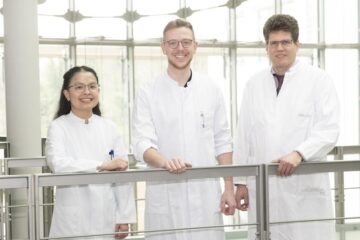Study reveals empirical evidence on role of intermediary firms in trade

A study by Columbia Business School Professors Amit Khandelwal, a Jerome A. Chazen Institute of International Business senior scholar and assistant professor, Finance and Economics, and Shang-Jin Wei, director, Jerome A. Chazen Institute of International Business, and N.T. Wang Professor of Chinese Business and Economy, Finance and Economics, alongside JaeBin Ahn, a Ph.D. candidate in economics at Columbia University, provides the first empirical evidence that quantifies the role of intermediary firms in developing and expanding international trade — data that can play an important role shaping US trade policies. Trade intermediaries help local producers import or export their goods and link to international markets.
Their study was published by the Journal of International Economics in its Volume 84, Issue 1, Pages 73-85), and is slated to be printed on May 11th. The online full text article is citable using DOI: 10.1016/j.jinteco.2010.12.003, and a link can be provided upon request.
While the study looked exclusively at China, its results are applicable across borders because it shows how all exporters, regardless of their homeport, face the same barriers when entering foreign markets. The study implies that once small firms export indirectly by using intermediary services, they could switch to interacting directly with their foreign clients. Firms that use intermediaries could become direct exporters more easily in subsequent periods.
To support their hypothesis, Khandelwal and his coauthors divided China's exporters into two groups: companies that export their goods directly into foreign markets, and companies that use intermediaries to manage their trade. They first leveraged the Enterprise Survey Data for Chinese firms collected by the World Bank that records direct and indirect exports at the firm level. First, they compared export values of new and incumbent varieties across markets and found that new varieties have relatively larger transaction values in smaller and high trade costs markets, precisely the markets where intermediaries play a relatively more important role. This suggests that although the customs data identify these varieties as new, it is likely that some firms used intermediaries to previously access these markets. They also provide more direct evidence for this hypothesis using a unique panel-level data on Ghanaian firms, which tracks their export status and export mode over time. They observe that firms using intermediaries in previous periods are more likely to export directly in subsequent periods than firms that did not use intermediaries. While these results are only suggestive, they provide the first evidence that intermediaries facilitate direct export participation.
Prof. Khandelwal discussed the implications this study has for future U.S. trade policies. “Our research shows that large firms can access markets on their own because they have the resources to do it, but smaller firms don't,” he says. “The US government could create policies to increase the types of firms that can facilitate exports.”
The study showed a direct link between the size of the firm and the use of trade intermediaries, implying that small firms can, and do, access foreign markets through intermediaries even when they aren't large enough to cover the fixed costs of direct exporting. And once small firms gain access to foreign markets, they can develop their own contacts there, enabling them to become direct exporters in the future. The model also predicts that intermediaries will be relatively more important in markets that are more difficult to penetrate.
About Columbia Business School
Led by Dean Glenn Hubbard, the Russell L. Carson Professor of Finance and Economics, Columbia Business School is at the forefront of management education for a rapidly changing world. The school's cutting-edge curriculum bridges academic theory and practice, equipping students with an entrepreneurial mindset to recognize and capture opportunity in a competitive business environment. Beyond academic rigor and teaching excellence, the school offers programs that are designed to give students practical experience making decisions in real-world environments. The school offers MBA and Executive MBA (EMBA) degrees, as well as non-degree Executive Education programs. For more information, visit www.gsb.columbia.edu.
About The Jerome A. Chazen Institute of International Business
The Jerome A. Chazen Institute of International Business serves as the focal point for Columbia Business School's major international programs and initiatives, and supports, sponsors and promotes thought leadership and frontier research on topics related to the global economy and business. The Institute provides forums for collaboration and learning among students, faculty members and the global community, connecting these constituencies with experiences, cultures and practices in markets across the globe. The Chazen Institute plays a leading role in shaping international business policy and education through research, symposia and conferences, experiential learning programs, curricular innovation and the creation of intellectual content and its translation to wider international business communities. For more information, visit www.gsb.columbia.edu/chazen
Media Contact
More Information:
http://www.columbia.eduAll latest news from the category: Business and Finance
This area provides up-to-date and interesting developments from the world of business, economics and finance.
A wealth of information is available on topics ranging from stock markets, consumer climate, labor market policies, bond markets, foreign trade and interest rate trends to stock exchange news and economic forecasts.
Newest articles

Simplified diagnosis of rare eye diseases
Uveitis experts provide an overview of an underestimated imaging technique. Uveitis is a rare inflammatory eye disease. Posterior and panuveitis in particular are associated with a poor prognosis and a…

Targeted use of enfortumab vedotin for the treatment of advanced urothelial carcinoma
New study identifies NECTIN4 amplification as a promising biomarker – Under the leadership of PD Dr. Niklas Klümper, Assistant Physician at the Department of Urology at the University Hospital Bonn…

A novel universal light-based technique
…to control valley polarization in bulk materials. An international team of researchers reports in Nature a new method that achieves valley polarization in centrosymmetric bulk materials in a non-material-specific way…





















